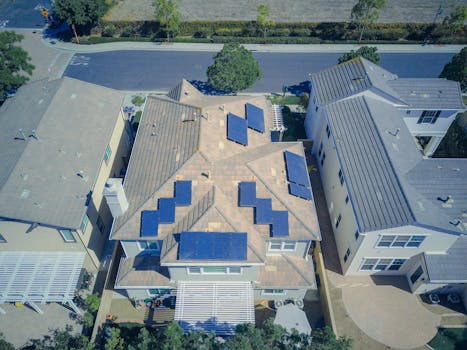“Empower Your Tiny Home: Essential Solar Wiring Insights for Sustainable Living.”
Solar wiring for tiny homes is an essential aspect of creating an efficient and sustainable energy system. As more individuals embrace minimalist living, understanding how to properly wire solar panels, batteries, and inverters becomes crucial for maximizing energy use and ensuring safety. This introduction covers the key components of solar wiring, including the types of solar systems available, essential wiring techniques, safety considerations, and tips for optimizing energy efficiency in compact living spaces. By grasping these fundamentals, tiny home owners can harness solar power effectively, reducing their carbon footprint and enhancing their off-grid capabilities.
Understanding Solar Wiring Basics for Tiny Homes
When considering solar wiring for tiny homes, it is essential to grasp the fundamental concepts that underpin this renewable energy system. Tiny homes, often characterized by their compact size and efficient use of space, present unique challenges and opportunities when it comes to solar energy. Understanding the basics of solar wiring is crucial for homeowners who wish to harness the power of the sun effectively and sustainably.
To begin with, it is important to familiarize yourself with the components of a solar power system. At the heart of this system are solar panels, which convert sunlight into electricity. These panels are typically mounted on the roof of the tiny home, maximizing exposure to sunlight. The electricity generated by the solar panels is direct current (DC), which must be converted to alternating current (AC) for use in most household appliances. This conversion is achieved through an inverter, a critical component that allows the solar energy to be utilized effectively.
In addition to solar panels and inverters, a complete solar power system for a tiny home includes batteries for energy storage. These batteries store excess energy generated during sunny days, ensuring that homeowners have access to electricity even when the sun isn’t shining. When selecting batteries, it is essential to consider their capacity and type, as these factors will influence how much energy can be stored and how long it can be used. Lithium-ion batteries, for example, are popular due to their efficiency and longevity, while lead-acid batteries are often more affordable but may require more maintenance.
Once you have a grasp of the components, the next step is to understand the wiring involved in connecting these elements. Proper wiring is crucial for ensuring safety and efficiency in your solar power system. The wiring must be appropriately sized to handle the current produced by the solar panels and to minimize energy loss. Using the correct gauge wire is essential; too small a wire can overheat and pose a fire risk, while too large a wire can be unnecessarily expensive and cumbersome.
Moreover, it is vital to consider the layout of your tiny home when planning the wiring. The compact nature of tiny homes means that space is at a premium, and efficient routing of wires can help maintain a clean and organized appearance. Additionally, careful planning can prevent potential issues such as voltage drop, which occurs when electricity travels long distances through wires, leading to reduced efficiency. To mitigate this, it is advisable to keep the distance between the solar panels, inverter, and batteries as short as possible.
Furthermore, understanding the electrical code requirements in your area is essential for compliance and safety. Local regulations may dictate specific wiring practices, grounding methods, and installation standards that must be followed. Consulting with a licensed electrician or solar installer can provide valuable insights and ensure that your system meets all necessary codes.
In conclusion, understanding solar wiring basics is a vital step for anyone looking to implement a solar power system in a tiny home. By familiarizing yourself with the components, wiring requirements, and local regulations, you can create an efficient and safe solar energy system that meets your needs. As the demand for sustainable living continues to grow, mastering these fundamentals will empower you to make informed decisions about your tiny home’s energy future. Embracing solar energy not only enhances your independence but also contributes to a more sustainable world.
Essential Components of a Solar Wiring System
When considering solar wiring for tiny homes, understanding the essential components of a solar wiring system is crucial for ensuring efficiency and safety. At the heart of any solar power system lies the solar panels, which capture sunlight and convert it into electricity. These panels are typically mounted on the roof of the tiny home, maximizing exposure to sunlight. The number of panels required will depend on the energy needs of the household, which can vary significantly based on lifestyle and appliance usage. Therefore, it is essential to conduct a thorough energy audit to determine the appropriate size and number of solar panels needed.
Once the solar panels are installed, the electricity generated must be directed to a charge controller. This component plays a vital role in regulating the voltage and current coming from the solar panels to the batteries. By preventing overcharging, the charge controller helps to extend the lifespan of the batteries, which are essential for storing energy for use when sunlight is not available. It is important to choose a charge controller that is compatible with the type of batteries being used, as this will ensure optimal performance and safety.
Following the charge controller, the next critical component is the battery bank. In a tiny home, space is often at a premium, so selecting the right type of batteries is essential. Lithium-ion batteries are becoming increasingly popular due to their high energy density and longer lifespan compared to traditional lead-acid batteries. However, lead-acid batteries may still be a viable option for those on a tighter budget. Regardless of the type chosen, it is important to ensure that the battery bank is adequately sized to meet the energy demands of the home, particularly during periods of low sunlight.
After the energy is stored in the battery bank, it must be converted into usable power for the home. This is where the inverter comes into play. The inverter transforms the direct current (DC) electricity stored in the batteries into alternating current (AC) electricity, which is what most household appliances require. When selecting an inverter, it is crucial to consider the total wattage of the appliances that will be used simultaneously. An inverter that is too small may not be able to handle the load, leading to potential system failures or damage.
In addition to these primary components, a solar wiring system for tiny homes also requires various wiring and safety equipment. Proper wiring is essential for connecting all components of the system, and it is important to use wires that are appropriately rated for the voltage and current they will carry. Furthermore, incorporating fuses and circuit breakers into the system is vital for protecting against overloads and short circuits, which can pose significant safety risks.
Finally, monitoring systems can enhance the efficiency of a solar wiring setup. These systems provide real-time data on energy production and consumption, allowing homeowners to make informed decisions about their energy usage. By understanding how much energy is being generated and consumed, tiny home dwellers can optimize their solar power system for maximum efficiency.
In conclusion, a well-designed solar wiring system for tiny homes involves several essential components, including solar panels, charge controllers, battery banks, inverters, and appropriate wiring and safety equipment. By carefully selecting and integrating these elements, homeowners can create a reliable and efficient solar power system that meets their energy needs while promoting sustainability.
Common Mistakes in Solar Wiring for Tiny Homes
When it comes to solar wiring for tiny homes, many enthusiasts are eager to embrace renewable energy but often overlook critical aspects that can lead to costly mistakes. One of the most common errors is underestimating the power requirements of appliances. Tiny homes may seem compact, but they can house a variety of devices that consume significant energy. Failing to accurately calculate the total wattage needed can result in an inadequate solar system, leading to insufficient power supply and frustration. Therefore, it is essential to conduct a thorough energy audit before selecting solar panels and batteries.
Another frequent mistake is neglecting to consider the placement of solar panels. While it may seem convenient to install them on the roof, factors such as shading from trees or nearby structures can drastically reduce their efficiency. It is crucial to assess the sun’s path throughout the day and choose a location that maximizes exposure. Additionally, the angle of the panels can influence energy production; thus, adjusting their tilt according to seasonal changes can enhance performance. By taking these factors into account, tiny home owners can ensure their solar systems operate at peak efficiency.
Moreover, many individuals fail to invest in quality wiring and connectors. Using subpar materials may seem like a cost-saving measure, but it can lead to significant issues down the line, including voltage drops and potential fire hazards. High-quality, appropriately rated wiring is essential for maintaining safety and efficiency in a solar system. Furthermore, ensuring that all connections are secure and weatherproof can prevent moisture-related problems that could compromise the system’s integrity.
In addition to wiring quality, another common oversight is the lack of proper fusing and circuit protection. Many tiny home owners may not realize that solar systems require specific fuses to protect against overcurrent situations. Without these safeguards, the risk of damage to the solar panels, batteries, and other components increases significantly. Therefore, incorporating appropriate fuses and circuit breakers into the design is a critical step that should not be overlooked.
Another mistake often made is the improper sizing of batteries. While it may be tempting to choose a smaller battery bank to save space, this can lead to rapid depletion and reduced lifespan of the batteries. Tiny homes often require a reliable energy source, especially during cloudy days or at night. Therefore, selecting batteries that can store enough energy to meet the household’s needs is vital. Additionally, understanding the depth of discharge (DoD) for the chosen batteries can help in maintaining their longevity and performance.
Furthermore, many tiny home owners may not fully understand the importance of a charge controller. This device regulates the voltage and current coming from the solar panels to the batteries, preventing overcharging and ensuring optimal battery health. Skipping this component can lead to battery damage and reduced efficiency. Therefore, investing in a quality charge controller tailored to the specific solar setup is essential for long-term success.
Lastly, a common mistake is the lack of regular maintenance and monitoring of the solar system. Many individuals assume that once the system is installed, it will function flawlessly without any attention. However, regular checks on connections, cleaning of solar panels, and monitoring battery health are crucial for ensuring sustained performance. By being proactive in maintenance, tiny home owners can avoid unexpected failures and maximize the benefits of their solar investment. In conclusion, by being aware of these common mistakes and taking the necessary precautions, tiny home owners can successfully harness solar energy, creating a sustainable and efficient living environment.
Safety Tips for Installing Solar Wiring in Tiny Homes
When it comes to installing solar wiring in tiny homes, safety should always be a top priority. The compact nature of these dwellings means that every inch of space is utilized, and this can lead to unique challenges when integrating solar power systems. To ensure a safe and efficient installation, it is essential to follow specific guidelines and best practices.
First and foremost, understanding the components of a solar power system is crucial. A typical setup includes solar panels, a charge controller, batteries, and an inverter. Each of these components must be correctly wired to function effectively and safely. Before beginning the installation, it is advisable to familiarize yourself with the electrical codes and regulations in your area. Compliance with local codes not only ensures safety but also helps avoid potential legal issues down the line.
Once you have a solid understanding of the components and regulations, the next step is to gather the necessary tools and materials. High-quality wiring, connectors, and protective gear are essential for a safe installation. Using the right gauge of wire is particularly important, as undersized wiring can lead to overheating and potential fire hazards. Additionally, ensure that all materials are rated for outdoor use, especially if any components will be exposed to the elements.
As you prepare for installation, it is vital to plan the layout of your solar system carefully. This includes determining the optimal placement of solar panels to maximize sunlight exposure while considering the structural integrity of your tiny home. When routing wires, avoid sharp edges and potential pinch points that could damage the insulation. Using conduit can provide an extra layer of protection for your wiring, especially in areas where it may be exposed to physical stress.
During the installation process, always prioritize safety by turning off all power sources before working on the system. This includes disconnecting the batteries and ensuring that the solar panels are not generating electricity. Wearing appropriate personal protective equipment, such as gloves and safety glasses, can further reduce the risk of injury. Additionally, it is wise to have a fire extinguisher nearby, as a precaution against any unforeseen incidents.
Once the wiring is in place, double-check all connections to ensure they are secure and properly insulated. Loose connections can lead to arcing, which poses a significant fire risk. It is also important to label all wires clearly, indicating their function and destination. This practice not only aids in troubleshooting but also enhances safety for anyone who may work on the system in the future.
After completing the installation, conducting a thorough inspection is essential. This includes testing the system to ensure that everything is functioning correctly. Monitoring the system regularly can help identify any issues before they escalate into serious problems. Furthermore, educating yourself about the signs of electrical issues, such as unusual smells or flickering lights, can empower you to act quickly if something goes wrong.
In conclusion, installing solar wiring in tiny homes requires careful planning and adherence to safety protocols. By understanding the components, using high-quality materials, and following best practices, you can create a safe and efficient solar power system. Remember that safety is an ongoing commitment; regular maintenance and vigilance will help ensure that your solar installation remains reliable and hazard-free for years to come.
Q&A
1. **What components are essential for solar wiring in tiny homes?**
Essential components include solar panels, charge controllers, batteries, inverters, and wiring (cables and connectors).
2. **How do you determine the appropriate wire size for solar installations?**
Wire size is determined by the current (amps) and the distance between components; use the American Wire Gauge (AWG) chart to select the correct size to minimize voltage drop.
3. **What safety precautions should be taken when wiring solar systems?**
Safety precautions include using proper fuses or circuit breakers, ensuring all connections are secure and weatherproof, and following local electrical codes and regulations.
4. **Can you connect solar panels directly to appliances in a tiny home?**
No, solar panels should not be connected directly to appliances; they must be connected through a charge controller and inverter to ensure proper voltage and current regulation.
Conclusion
When considering solar wiring for tiny homes, it’s essential to understand the specific energy needs, select appropriate solar panels and inverters, and ensure proper wiring techniques to maximize efficiency and safety. Additionally, understanding local regulations and potential incentives can aid in the installation process. Proper planning and execution will lead to a sustainable and cost-effective energy solution for tiny home living.




